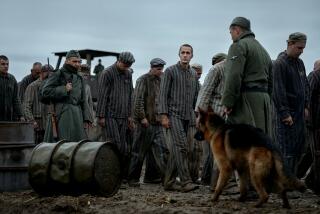Incomplete ‘Carrier’ mission
- Share via
As documentaries go, it’s a real commitment signing on for the tour that is “Carrier,” a 10-hour PBS series about life aboard the nuclear-powered aircraft carrier Nimitz on a trip to the Persian Gulf and back.
Premiering Sunday night and taking up almost half of the week’s public-broadcasting prime time, it might be viewed by a suspicious or uncharitable critic as the network demonstrating to its conservative critics that it knows how to wave the flag. Although there is no politicking by the filmmakers or much political expression from the people in it, “Carrier” is not incidentally a paean to military hardware and the men and women who work it, live in it, and keep it organized and clean.
And the Navy does not, of course, let people with cameras onto its boats in the first place unless it thinks it will do it more good than harm. (Or perhaps it does not let them off its boats if it thinks otherwise.) There is only so much truth any institution wants to handle.
But apart from whatever assurances the brass may or may not have been given, it is natural enough that after traveling for six months cheek-by-jowl with people who are (as seen here) hard-working, dedicated, friendly and all too human, the filmmakers would finally send them a valentine.
Even from a critical standpoint, one wants to make clear that, as with the Iraq war itself, one’s problem with the film is never with the troops, but with the thing they have volunteered for.
It’s an inherently interesting idea for a film: Not only does an aircraft carrier contain a world most of us will never see, but “people thrown together in tight spaces” is almost the definition of drama. (Couch potatoes will recognize the roots of “Battlestar Galactica.”) More than one person compares the carrier to a small town, though -- as director Maro Chermayeff (“Frontier House”) has pointed out -- it is very much like a high school. (The average age of the crew, some 5,000 strong, is just 19.)
And I am all for long documentaries -- I’m there with bells on for anything by Frederick Wiseman or David Sutherland -- which can more closely convey the rhythms and layers of real life. But even at 10 hours, “Carrier” feels cursory and incomplete.
That’s not to say that at most any given moment it’s uninteresting -- it’s quite watchable -- just that it doesn’t add up to as much as it should.
A thing largely made of snippets and sound bites, it’s restless and choppy, even when describing days of tedium.
Its aesthetics are too often those of Madison Avenue. Pop songs, overly loud on the soundtrack, needlessly amplify the obvious majesty of the ship, the seas, the jets and the mission, but more crucially swamp the series’ small, delicate, human moments, making sentimental and “cinematic” what would otherwise be plainly moving.
This is especially true toward the end, when friends bid goodbye and families awkwardly reunite.
Just stripping off the soundtrack would improve the series by half.
The people we meet here have joined the Navy for all sorts of reasons, patriotic or practical or romantic; there is some diversity of opinion on the war, God and life -- though having opinions is not necessarily what leads to success in this world, described by one sailor as “a floating dictatorship defending a democracy.”
It is a more homogeneous society than most, and yet diverse within those bounds, separated not so much by color and creed as by rank and job. Dissension is acknowledged in the series -- talking heads, often shot against a black background, speak up for themselves -- but it’s not really shown being explored.
Much of what makes up the narrative is described rather than seen, but the best passages are the ones that speak for themselves -- a long episode in which planes, sent up for practice, have difficulty landing while the ship pitches in rough seas is especially involving. “The first thing,” says one officer, “you don’t want to lose anybody. And number two, the airplanes are pretty expensive.”
And while most of the personnel the series closely tracks stay flat, some do emerge as memorable -- none more than a buff, broken-nosed, salsa-dancing gunnery sergeant whose carny parents abandoned him at 3 to a life of abuse. A complex mix of rage and sweetness, he comes into the series late and lifts it up. I wanted to know him better.
As more than one sailor attests, the lives the Navy mostly saves would seem to be those of its own sailors.
--
--
‘Carrier’
Where: KCET
When: 9 to 11 p.m. Sunday through Thursday
Rating: TV-PG (may be unsuitable for young children)
More to Read
Only good movies
Get the Indie Focus newsletter, Mark Olsen's weekly guide to the world of cinema.
You may occasionally receive promotional content from the Los Angeles Times.











